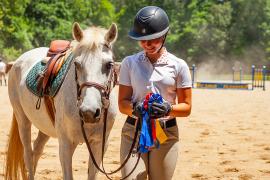“Camp is not all about the performance, but the pursuit — the pursuit of relevant experience and knowledge.”
The following article by ACA CEO Peg Smith* appeared in USA TODAY on February 1 and 4, 2013.
What is the path to innovation — spending alone time in a seat or actively engaging in learning that helps one become adaptive, ambiguity-able, and alert? What will help create tomorrow’s innovators? One thing is clear: We will need innovators. Maybe we should spend as much time considering how we develop innovators as we do graduates. I believe a balanced approach is imperative — to life and to education.
Robert C. Pianta, PhD, found that fifth graders spend 90 percent of their time in their seats listening or working alone (Bromley, 2007). That statement seems counterintuitive to what we know about child and brain development. If play is a form of invention, and invention seeds innovation, where does active learning take place today? Where are the safe places that young people can experience risk taking, explore new activities, and gain new skills while exercising their natural curiosity to learn? Where can children enjoy lessons that are experiential and relevant to their social, emotional, physical, and cognitive development?
I believe, absent of positive play, we are seeing children manifest social and emotional behaviors that are developmentally underdeveloped. They are not prepared to work with others or participate successfully outside of the family unit. They have not learned to manage conflict or solve problems in cooperation with others. Yet, maybe most disturbing, they have not had a chance to exercise their creative and innovative muscles — the opportunities to make mistakes, reflect, persist, and survive setbacks or defeat. This is the “grit” discussed by many, including Paul Tough, author of How Children Succeed: “Overcoming adversity is what produces character. And character, even more than IQ, is what leads to real and lasting success” (2012).
I believe the camp experience is a classroom without walls that young people deserve and need today. Yet, it is said that the radius of play has shrunk from 1 mile to 500 feet. That time spent outdoors has declined by 50 percent in the last two decades. That by age twenty-one, a young person will have spent 10,000 hours in front of a screen. (It only takes 4,800 hours to acquire a bachelor’s degree.) A balanced approach to childhood will create tomorrow’s innovators. Our new environment is understood, but long-standing, important elements of development must be preserved.
Innovators in the future will need minds capable of synthesizing and making new meaning. Experiential learning environments such as camp give young people the opportunity to rehearse and refine ways of thinking and doing that afford an expansion of possibilities. Innovators will be critical. It is not just those who have imaginations thinking up new ideas, but innovators who will take action, make change, and make a difference.
Innovators must be comfortable with mistakes and capable of learning from mistakes; they must be persistent with a stomach for imperfection. In his blog, Vernon Lun (2006) writes that “being innovative . . . requires disruptive thinking, which is an evolutionary process with many failures along the way. That’s tough to do especially since all of us are taught that failure is bad and we try to avoid it at all costs.” Camp is not all about the performance, but the pursuit — the pursuit of relevant experience and knowledge. Learning is risky.
A positive, healthy camp experience is an oasis for many young people in today’s complex, frenetic world. It is a laboratory of maturation encouraging discovery, reflection, and possibility. Like nature, the camp community is a diverse, dynamic system that uses creativity to find new meaning. Camp allows one to synthesize his or her best intuition, life lessons, and creativity to discover new learning and a harmony with the natural world and fellow campers (citizens) — an extraordinary gift in today’s world.
Consider camp for your young innovator — camp can inspire the power of imagination, spirit, and entrepreneurial flair.
References
Bromley, A. (2007 March 29). Elementary school classrooms get low rating on high-quality instruction. UVA Today. Retrieved from http://news.virginia.edu/content/elementary-school-classrooms-get-low-rating-high-quality-instruction
Lun. V. (2006 March 27). Disruptive thinking. The Idea Dude. Retrieved from www.theideadude.com/2006/03/disruptive-thinking.html
Tough, P. (2012). A conversation with Paul Tough. Retrieved from www.paultough.com/the-books/how-children-succeed/extras/
Photo courtesy of YMCA Camp Kitaki, Lincoln, Nebraska
*Peg Smith is the former CEO of the American Camp Association, having retired on January 1, 2015
The views and opinions expressed by contributors are their own and do not necessarily reflect the views of the American Camp Association or ACA employees.



